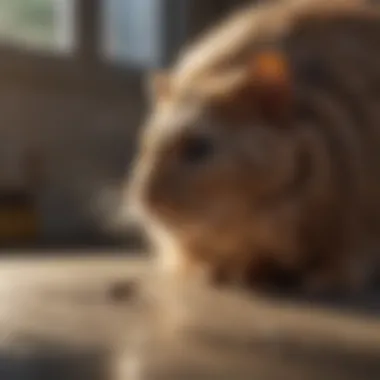Evaluating Bifen Pesticide Safety for Pets


Intro
In households where pets frolic and roam, ensuring their safety becomes paramount. As many homeowners grapple with pesky intruders like ants or spiders, Bifen, a widely utilized pesticide, can be tempting as a quick fix. However, the relationship between pet safety and chemical control is fraught with concerns, making it essential to dissect this interaction carefully.
With various pest species wreaking havoc in homes, understanding the nuances of pest control and its implications for our furry companions is crucial. This article aims to not only unravel the safety of Bifen, but also explore preventive measures, alternative options, and responsible application techniques for pet owners.
Understanding Pests
Definition of Pests
Pests are those uninvited guests in our lives, often disrupting the serenity of our homes. They range from tiny insects, like fleas and cockroaches, to larger nuisances like rodents. Recognizing what qualifies as a pest is the first step in managing them effectively. Common pets' pests include:
- Fleas
- Ticks
- Mice
- Ants
Importance of Pest Identification
Identifying the specific type of pest is paramount; not every solution fits every problem. Misidentifying a household nuisance can lead to ineffective control efforts and, worse, undue risk to pets. For example, certain products that kill ants may not target roaches and could potentially harm pets. Proper identification allows for targeted strategies that minimize exposure and maximize efficacy.
Prevention Techniques
Home and Garden Preventative Measures
Preventing pests begins at home. Maintaining a clean environment is your first line of defense. Here are a few tips:
- Seal cracks and crevices to block entry points.
- Store food in airtight containers.
- Regularly empty pet food bowls to avoid attracting unwanted critters.
- Keep gardens tidy; remove any debris or standing water that might harbor pests.
Seasonal Prevention Tips
Different seasons bring different pests. Understanding these rhythms can keep pets safer:
- Spring: Inspect for termite activity as they emerge following warmer weather. Treat wood structures accordingly.
- Summer: Keep an eye on fleas and ticks, which thrive in warm months. Regular grooming and baths for pets can minimize risks.
- Fall: Rodents may seek shelter indoors. Maintain vigilant checks on attics and basements.
- Winter: Pests, including cockroaches, can find refuge in homes. Regular cleaning during colder months is advisable.
Eco-Friendly Pest Control Solutions
Overview of Sustainable Practices
While chemical pesticides like Bifen may offer short-term solutions, sustainable pest control is gaining traction. Utilizing methods that respect the environment can reduce chemical residue in our homes, promoting a healthier living space for pets.
Natural Remedies and Their Effectiveness
Many pet owners opt for natural remedies, often seen as safer. Some popular solutions include:
- Diatomaceous earth—effective against crawling insects.
- Essential oils like peppermint or lavender—act as deterrents for various pests but must be used cautiously around pets.
"Natural doesn't mean safe; always check for pet safety before using any remedy."
Combining basic prevention strategies, identification, and eco-friendly solutions, pet owners can ensure their homes remain pest-free without jeopardizing their furry friends' well-being. As Bifen and other chemical solutions linger in the air of discussion, the onus lies on owners to make informed, conscientious choices for the safety of both their pets and the environment.
Understanding Bifen
In the realm of pest control, knowlege of the substances we utilize is crucial especially when our furry companions are involved. Understanding Bifen serves as a gateway to grasping not only its effectiveness but also the potential hazards it might pose to pets. This knowledge empowers pet owners to make informed decisions and adopt safe practices when applying pesticides in their homes.
Bifen is often the go-to for homeowners facing rodent and insect invasions. However, while it executes its duties efficiently, the need to acknowledge its implications on pet safety cannot be overstated. Evaluating the components and functions can help us navigate the balance between maintaining a pest-free home and ensuring our pets' well-being.
Definition and Composition
Bifen, or bifenthrin, belongs to a group of pesticides known as pyrethroids. These are synthetic compounds modeled after naturally occurring pyrethrins derived from chrysanthemum flowers. Bifen effectively disrupts the nervous systems of insects, offering a potent solution to various pest problems. The chemical formula for bifenthrin highlights its complexity, with its molecular structure enabling it to resist degradation under UV light and to maintain effectiveness over time.
Veterinarians and pet owners should pay attention to the specific ingredients in any Bifen formulation, as some variations may include additional chemicals that are harmful to pets. Understanding its composition helps in evaluating risk and safe application methods.
Primary Uses in Pest Control
Bifen plays a pivotal role in controlling a wide array of pests. It is primarily used against hard-to-kill pests such as ants, roaches, and spiders. It is frequently utilized in both residential and commercial settings, proving to be instrumental in creating pest-free environments. Bifen's versatility can be seen in its various applications, from lawn treatments to inside the house.
- Flea Control: Many pet owners use Bifen in yard treatments to reduce flea populations, which can harm both humans and pets.
- Termite Treatment: Homeowners often apply it to protect their property from termite damage, understanding the potential risks involved for their pets in the vicinity.
- Landscape Maintenance: In the garden, Bifen can assist in controlling nasty pests that threaten plants but can inadvertently affect the health of domesticated animals.
Active Ingredients and Their Functions
The active ingredient in Bifen is bifenthrin, and its strategic function comes into play when we consider its mechanism against pests. Bifenthrin targets specific channels in the neurons of insects, causing paralysis leading to their demise. This precision against pests is what makes it highly favored in pest management, while being relatively less harmful to mammals, including dogs and cats.


Still, it’s essential to mention that while Bifen does not affect pets in the same way insects are affected, exposure can lead to different health issues depending on the exposure level and the pet’s size. Understanding how and when these active ingredients can cause reaction allows pet owners to mitigate risks effectively.
In summary, recognizing what Bifen is made of, along with how it's utilized, forms a foundational understanding that is critical when considering its application in environments shared with pets. As we delve further into the implications of Bifen, it becomes apparent just how crucial awareness is in safeguarding our beloved animals during pest control efforts.
The Mechanism of Action
Understanding how Bifen interacts within its environment, particularly when targeting pests, is crucial in assessing its overall safety. This section explores the subtleties of Bifen's effectiveness and its potential repercussions for pets as well as other non-target species. By exposing the connections between Bifen’s activity and its applications, readers can better gauge the risks entailed in its use.
How Bifen Affects Pests
Bifen, also known as bifenthrin, is a synthetic pyrethroid that primarily affects insects by targeting their nervous system. When pests come into contact with this chemical, it disrupts the normal neural functions, effectively leading to paralysis and death. This action is somewhat akin to a chain reaction, causing a cascade of neurotoxic effects that are swift and lethal to insects.
One of the notable aspects of its mechanism is its persistence. Bifen can remain active in the treated area for several weeks, ensuring continued protection against insect invasions. However, this longevity also raises flags when it comes to the safety of pets. Animals, especially curious ones, are prone to investigate their surroundings. Here’s how Bifen may affect pests:
- Neurotoxicity: As previously mentioned, its primary action on insects is neurotoxic, leading to fast-acting paralysis. This is beneficial in pest control but raises concerns for pets that might inadvertently ingest or come into contact with it.
- Disruption of Behavior: Pests may exhibit erratic behavior before succumbing to the effects of Bifen, which can be seen as a signal of a larger issue when evaluating its safety around pets. Any behavior change in pets can often be a cause for concern among owners.
Implications for Non-Target Species
The implications of Bifen's action extend beyond pests and can have significant repercussions for non-target species, which includes household pets and other wildlife. While Bifen is designed to target specific insects, the reality is that many animals share habitats, thereby increasing the likelihood of accidental exposure.
As we delve into the implications for pets, it becomes apparent that:
- Risk of Accidental Ingestion: Pets, especially dogs and cats, may unknowingly ingest Bifen if they lick treated surfaces or consume insects affected by the pesticide. This can lead to unintentional poisoning.
- Ecological Disruption: The chemical can also impact beneficial insects, such as bees and ladybugs, which are crucial for pollination and ecological balance. The knockout effect on these species can disrupt local ecosystems, which can indirectly affect pets by altering their environment.
"Understanding the broader implications of Bifen's use is vital; not just for the pests it targets but for other animals that might share that space and possibly encounter harmful effects."
To summarize, while Bifen effectively reduces insect populations through a robust mechanism anchoring on neurotoxic actions, it also presents considerable concerns regarding safety for pets and other non-target species. Therefore, careful application and consideration of surrounding animal life are essential to mitigate the risks involved.
Research on Bifen and Pet Safety
Understanding how Bifen interacts with pets is crucial for pet owners, particularly for those who desire a safe and comfortable environment for their furry companions. The topic encompasses countless studies and observations that shed light on the implications of chemical exposure through Bifen. Collectively, these findings not only inform us about potential hazards but also help in formulating application practices that prioritize the health of our pets.
When we speak about Bifen, we delve into its efficacy as a pesticide, yet it’s essential to critically evaluate how it impacts non-target species, primarily our beloved pets. This section will emphasize research that looks at how pets can be inadvertently affected by the use of such chemicals in our households or gardens.
Studies on Chemical Exposure
Numerous studies have been conducted to investigate the effects of chemical exposure from pesticides like Bifen on pets. Many of these studies focus on specific instances of pets being present in environments where Bifen was applied. For instance, it has been documented that dogs and cats can develop reactions ranging from mild gastrointestinal upset to more severe neurological symptoms when exposed directly to treated surfaces or through ingestion of grass or soil that has been contaminated.
In one particular case, researchers observed that dogs who frequently roamed areas that had received Bifen treatments showed higher instances of lethargy and vomiting than those who spent little to no time in treated zones. Such insights underline the importance of considering where and how these chemicals are utilized to establish safer backyard and home environments for pets.
"Always remember, even the most effective pest control methods can come with strings attached, especially when pets are involved."
Another significant aspect of these studies includes identifying preventative measures that can be taken post-application to minimize the risk to pets.
Toxicity Levels in Common Pets
The toxicity of Bifen can vary greatly between different species, making it an essential aspect to explore. Cats, for example, are particularly sensitive to many pesticides, including Bifen. Research indicates that even a small exposure could potentially lead to significant health repercussions in felines. Symptoms observed in affected cats may include irregular heartbeats, tremors, or even seizures in extreme cases.
- Dogs, while generally more resilient than cats regarding pesticide exposure, are not exempt from risks. Bifen can trigger a range of symptoms based on the amount and duration of exposure. Common symptoms include
- Excessive drooling
- Loss of coordination
- Allergic reactions like rashes or itching
Rabbits and other small mammals, such as guinea pigs, are also at risk, with reactions similar to cats if exposure to Bifen occurs.
In summary, it is prudent for pet owners to be aware of the specific risks associated with Bifen exposure in their pets, ensuring a cautious approach in pest management practices. Regularly consulting research and remaining vigilant are key components in safeguarding our pets from potential dangers while managing pest issues effectively.
Potential Risks Associated with Bifen
Understanding the potential risks associated with Bifen is crucial for pet owners. This section aims to shed light on specific dangers linked to Bifen exposure, including acute and chronic effects on pets. Knowing these aspects can help pet owners make thoughtful decisions regarding pest control around their furry family members. It is vital to weigh the benefits and risks to create a safe environment for both pets and humans.
Acute and Chronic Effects on Pets
When pets come into contact with Bifen, the effects can fall into two categories: acute and chronic. Acute effects appear shortly after exposure, while chronic effects might develop over a longer time.
Acute Effects can vary based on the level of exposure and the type of pet. For instance, dogs may show signs of distress almost immediately after ingesting or coming into contact with treated surfaces. Symptoms may include:
- Vomiting
- Diarrhea
- Excessive drooling
- Lethargy
- Seizures in severe cases
In some instances, severe reactions may lead to hospitalization, depending on the dosage and individual pet sensitivity.


Chronic Effects refer to the long-term damage caused by continuous low-level exposure. While these can be more insidious, they often show up as gradual health deterioration. Symptoms of chronic toxicity can include:
- Behavioral changes, like increased anxiety or aggression
- Changes in appetite, leading to weight loss
- Compromised immune system, making pets more susceptible to infections
- Organ damage, particularly affecting the liver and kidneys
It is essential to recognize that different pets react differently. For example, a small dog might suffer far more from a dose intended for larger animals. Each pet's unique health status and sensitivity must be considered when discussing the risks associated with Bifen.
Symptoms of Bifen Poisoning
Identifying symptoms of Bifen poisoning in pets can be a matter of life and death. Pets might not always show clear signs of distress immediately, hence vigilance on the owner’s part is key. Symptoms of poisoning may include:
- Heavy breathing or panting
- Uncoordinated movement or staggering
- Increased heart rate
- Skin irritation or rashes, particularly in pets with allergies
If a pet exhibits these signs, it’s critical to act swiftly. According to experts, if you suspect poisoning, immediate veterinary attention could save your pet's life. The vet may perform tests to determine Bifen’s presence in your pet, followed by appropriate treatment.
In short, the potential risks associated with Bifen necessitate careful examination and responsible usage by pet owners. Making informed choices can help ensure that pest control methods do not compromise pet safety.
Safe Application Practices
Safe application practices are paramount when it comes to using Bifen, particularly for households that include pets. The methods one employs not only affect the effectiveness of pest control but also play a crucial role in mitigating risks associated with chemical exposure. By applying safe practices, pet owners can create a more secure environment while effectively managing pest problems. Understanding these practices can help ensure that the benefits of pest control do not come at the expense of a pet's health.
Guidelines for Safe Use Around Pets
When using Bifen, pet owners must prioritize guidelines tailored for the safety of their furry companions. These include:
- Read the Label: Always begin by reading the product label thoroughly. This includes dosage, application guidelines, and specific warnings regarding pets.
- Choose Timing Wisely: Apply Bifen when pets can be kept away from treated areas. Early mornings or late evenings might work best, reducing their exposure while ensuring the effectiveness of the product.
- Create Boundaries: Consider using barriers or physically restricting pets from accessing treated areas until the product has dried completely. This can prevent accidental contact with the chemicals.
- Opt for Targeted Applications: Instead of broad spraying, favor targeted applications in areas where pets do not frequent as much, like basements or attics.
- Ventilate: Ensure adequate ventilation during and after application. Open windows or doors can help disperse the chemical presence in the air.
By taking these precautions, pet owners can significantly reduce the risk of exposure to Bifen, allowing for effective pest management without compromising pet safety.
Post-Application Precautions
Even after applying Bifen, it's crucial to maintain certain post-application precautions to ensure ongoing safety for pets. These practices help in minimizing risks associated with lingering chemical residues.
"An ounce of prevention is worth a pound of cure." Taking simple steps post-application can safeguard our pets from unexpected harm.
- Cleanup and Disposal: After the application, tidy up any spillage immediately. Dispose of any leftover product as per local guidelines to prevent pets from coming into contact with it later.
- Deter Entry: Keep pets away from the treated area for at least the time advised on the product label, often a couple of hours or until fully dried. This is essential to prevent ingestion or skin contact.
- Monitor Health: After applying Bifen, observe pets for any unusual behavior or signs of distress. If any symptoms are noticed, consult a veterinarian without delay.
- Routine Cleaning: Maintain a regular cleaning schedule for areas where Bifen was applied. This can help in reducing chemical residues that may inadvertently affect your pets.
- Inform Household Members: Ensure that all household members, especially children, are aware of the application and its associated risks, fostering a collective approach to safety.
Incorporating these simple yet effective practices offers not only peace of mind to pet owners but also reinforces a commitment to responsible pest management.
Exploring Alternatives to Bifen
Considering the safety of our beloved pets, exploring alternatives to Bifen isn’t just an afterthought; it’s a pivotal part of responsible pest management. With the growing awareness around chemical exposure and its implications, pet owners are increasingly looking for options that keep their homes pest-free without the risks associated with certain pesticides. Understanding the multitude of alternatives available underlies a dedicated approach to creating a safer environment for both pets and family.
Eco-Friendly Pest Control Solutions
Unleashing the power of nature, eco-friendly pest control solutions offer a roster of options that are less harmful to pets. Many of these solutions utilize naturally occurring substances that deter pests effectively without doing harm to non-target species. Just think about it—who wouldn’t want a pest-free home that also champions environmental health?
Some prevalent eco-friendly pest control methods include:
- Essential oils: Oils like peppermint or tea tree are known to repel pests without any chemical additives. Just a few drops in a diffuser or diluted in water can create a protective barrier around your abode.
- Diatomaceous earth: This natural powder is made from tiny fossilized algae and works by dehydrating and killing pests. It’s safe for pets when applied correctly, making it a favorite among natural-minded homeowners.
- Vinegar and soap mixtures: A simple concoction can work wonders. Mixing equal parts of vinegar and water, along with a dash of dish soap, creates a potent spray that tackles various pests without harmful residues.
These solutions not only offer a safer alternative, but they also promote a healthier living environment. So, for anyone worried about their pets’ safety around traditional pest control, these eco-friendly methods are worth considering.
Integrated Pest Management Strategies
When it comes to a comprehensive approach, Integrated Pest Management (IPM) stands out as a multifaceted strategy. It combines various techniques for effective pest control while minimizing risks to your pets and the environment. This systematic approach not only tackles the immediate problem but also gets to the crux of preventing future infestations.
Key components of IPM include:
- Monitoring: This involves regular inspections of your home and garden. Being proactive enables you to catch pest problems early—before they turn into serious infestations. Often, you can identify whether a pest is a genuine threat or just a fleeting visitor.
- Prevention: Simple steps create a protective barrier. This could involve sealing cracks, keeping food in airtight containers, and removing standing water. With these measures, you create a less inviting atmosphere for pests.
- Cultural Control: This refers to changing habits and conditions to make your environment less hospitable to pests. For instance, rotating crops in your garden can limit the spread of plant-specific pests.
- Mechanical and Physical Controls: Utilize traps and barriers. For example, fly traps or insect vacuums can humanely deal with pests without the risk of chemical exposure.
- Targeted Chemical Use: When necessary, opting for targeted, less toxic pesticides that have minimal risks for pets and humans is the final line of defense. Using them sparingly and strategically can help maintain both efficacy and safety.
"Prevention is better than cure." Integrating these practices establishes a holistic pest management approach that minimizes dependence on chemical treatments, ensuring not just a pest-free zone but also peace of mind for pet owners.
Legislation and Guidelines on Pesticide Use
Understanding the laws governing pesticide use, including Bifen, is crucial for pet owners. These regulations aim to protect not just the environment but also unwitting animals who may find themselves exposed to harmful chemicals. The importance of adhering to these guidelines cannot be overstated when considering the safety of pets in households. The rules put in place help to ensure that any pesticide used, whether for pest control in gardens or homes, is effective while minimizing risks to pets and their human companions.
Regulatory Standards for Pesticides
Pesticide regulations vary by region, and it's essential for pet owners to be aware of these variations. At the federal level, agencies like the Environmental Protection Agency (EPA) oversee pesticide registration to ensure product safety before they hit the market. Each pesticide, including Bifen, must undergo rigorous testing to determine its effects on non-target species, which can include pets.


- Risk Assessment: Testing includes toxicity studies to assess what levels of exposure might pose a risk. This ensures that products considered safe in moderate use do not pose an undue risk to animals.
- Labeling Standards: Manufacturers must provide specific labeling that includes how to safely use the pesticide around animals. This information is indispensable for pet owners to read carefully before application.
In addition to federal regulations, many states have their own laws regarding pesticide application, often more stringent than federal ones. Pet owners should be informed about these local regulations and ensure compliance.
Label Instructions and Compliance
Each pesticide should come with comprehensive labeling. These labels serve as a guide on how to use the product safely, providing specific information on dosage, application methods, and safety precautions. Adhering to the label instructions is not merely a guideline; it’s a regulatory requirement.
- Usage Guidelines: The label often details how long you should keep pets away from treated areas. Ignoring this can lead to serious health implications.
- Emergency Protocols: Labels also provide emergency contact information and guidance on what to do if a pet is accidentally exposed.
Proper compliance with these instructions can make a significant difference. Failing to heed the warning can result in unwanted exposures, and can also lead to endangering other local wildlife. Moreover, some formulations of Bifen may possess specific application requirements, like not using it near water sources where pets may drink or play, according to local regulations.
"When using pesticides like Bifen, always follow the label instructions carefully to ensure the safety of your pets and the environment.”
Ultimately, being aware of and complying with legislation and guidelines not only protects your pets but also fosters responsible usage of chemicals in our communities.
Consulting Professionals
Navigating the world of pesticides, particularly Bifen, can be convoluted, especially when pets are involved. Consulting professionals is not merely a recommendation but a crucial step to ensuring the safety and well-being of your furry friends.
Expert advice comes from both veterinarians and pest control specialists, as each has a unique perspective on the implications of pesticide use around pets. Veterinarians can provide insights into how specific chemicals affect different animals, helping you assess the risks based on your pet's species, age, and health status. Pest control experts, on the other hand, can guide you on effective application methods that minimize exposure while still addressing your pest problems. Together, their expertise allows for a more comprehensive understanding of potential hazards, ensuring that informed, safe choices are made regarding pest management.
Advice from professionals can be the difference between a safe home and one fraught with hidden dangers.
When to Seek Veterinary Advice
Understanding when to consult a veterinarian is critical in ensuring your pet's health when using Bifen or any pesticide. If your pet has shown symptoms of distress, especially after recent pest control applications, it's vital to reach out immediately. Signs such as vomiting, lethargy, or unusual behavior warrant an urgent call to your vet.
Moreover, if you are considering using Bifen, discussing it beforehand can provide valuable context. Your veterinarian may help you consider alternative pest control solutions or suggest specific safety measures tailored to your pet's particular needs.
- Key situations to consult a veterinarian include:
- Concerns about potential poisoning or exposure
- Pre-existing health conditions in pets
- Uncertainty about the appropriate doses if using pet-safe treatments
Collaborating with Pest Control Experts
When dealing with pests in your home, working alongside pest control professionals can make all the difference. These specialists are trained not just in effectively eliminating pests but in doing so with minimal risks to pets. They can provide tailored strategies for your specific situation, ensuring that you implement best practices that protect your furry companions.
Collaboration here is about communication. Clearly expressing your concerns about pet safety can help pest control specialists formulate a plan that respects both your need for a pest-free environment and the health of your beloved animals. They may suggest:
- Timing of applications when pets are least likely to be exposed
- Use of barriers or alternate methods that reduce risk
- Education on the signs of pesticide exposure to watch for after treatment
Utilizing their expertise allows you to strike a balance between effective pest control and maintaining a safe, pet-friendly space in your home.
Overall, consulting professionals ultimately forms a safety net for both you and your pets. Their combined knowledge can guide you toward informed decisions, making the pest control process less intimidating and more effective.
In Summary: Is Bifen Safe for Pets?
When it comes to pest control, responsibility is key, especially for pet owners. The question of whether Bifen is safe for pets encompasses not just a matter of chemical exposure but also reflects our broader duty to protect our furry companions. It’s essential to gather all the necessary information before making any decisions about its use. Understanding the balance between effectiveness against pests and the safety of our pets can make a huge difference in informing our choices.
Weighing Benefits Against Risks
First and foremost, we must consider the benefits that Bifen offers as a pest control agent. It effectively targets a range of insects, making it a popular choice among homeowners dealing with pesky infestations. ❗ However, this effectiveness should not come at the cost of our pets’ health.
- Benefits of Bifen:
- Broad-spectrum activity against insects.
- Long residual effects, meaning it continues to work after application.
- Versatile use in various environments, inside and outside homes.
But then again, we must look at the risks. Bifen contains chemicals that can potentially harm pets if they come into contact with treated surfaces. Symptoms of exposure can range from mild irritations to more serious health issues.
- Risks of Bifen:
- Possible toxic reactions in pets upon contact.
- Potential for ingestion, particularly if pets engage in licking treated areas.
- Varying levels of sensitivity depending on species; for example, cats often exhibit a higher susceptibility than dogs.
So, when weighing the benefits against the risks, it becomes evident that a cautious approach is prudent. Pet owners must ensure they’re well-informed about how to apply Bifen safely, creating a balance where they can keep their environments pest-free without jeopardizing their pets’ well-being.
Promoting Responsible Pest Management
It’s one thing to strive for a pest-free home, but another to do so responsibly. Implementing safe practices is crucial for minimizing risks associated with Bifen. Here are some recommendations for pet owners:
- Read the Label Thoroughly: Before using any pesticide, including Bifen, always adhere to the instructions provided on the label. These guidelines are established to protect both users and their pets.
- Application Timing: Apply Bifen when pets are not around. This helps prevent exposure during and right after the application and allows for chemicals to settle on surfaces.
- Ventilation: Ensuring proper air flow during and post-application is necessary to disperse any lingering chemicals, making the environment safer for your pets.
- Regular Cleaning: After the application, cleaning surfaces that pets frequently come into contact with will help remove any residual chemicals.
Pet owners should also be mindful of alternatives to chemical-based pest control. By consulting professionals and exploring environmentally friendly options, one can manage pest problems effectively while maintaining a safe abode for pets. The balance struck between necessary pest control and the health of our pets can create a harmonious living space that addresses the needs of both.
"Ultimately, informed choices lead to safer environments for our beloved pets and the ecosystem we share."



